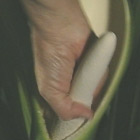A tough indoor plant commonly found sitting unobtrusively in the corners of living rooms across Australia is Philodendron bipinnatifidum (sold as P. selloum). No-one would suspect the complexity of its sex life and the unusual activities undertaken by commercial propagators to ensure continued production of this plant.
This philodendron doesn’t produce much in the way of stems which could be used to strike as cuttings and so has to be grown from seed. In its native Central America a night flying moth assists in pollinating the plant as it flutters around the blooms. But in Australia, in the absence of this moth, human intervention is required to ensure pollination takes place.
Another factor which makes everything even more complicated is that each flower becomes heavily perfumed and sexually receptive on just one night in the year. Different flowers bloom on different nights over a period of about three months.
A philodendron flower is ready to be pollinated when it is open and the bottom part, which is the female portion, is hot. The flower warms to a temperature of about 35.5



